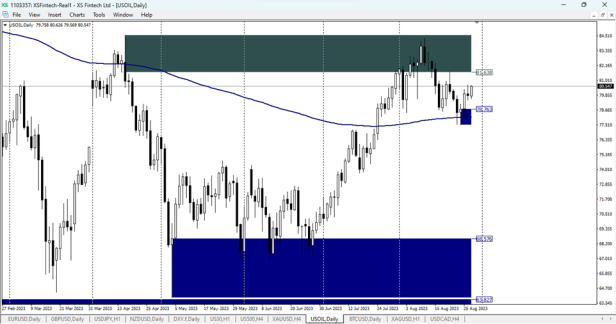Oil Prices Hang in the Balance: A Tight Spot in the Market
Crude oil continues to feel the chill of negative pressure for a second straight day. Prices touched the 200‑day simple moving average support line at $79.50 per barrel during early European trading hours on Tuesday, only to bounce back and settle at $80.45 shortly thereafter.
What’s Stirring the Market?
- US inventory data on the horizon – Expect new numbers next Wednesday that could sway the price swing.
- Saudi Arabia’s wallets are lighter – Net foreign assets fell by up to $16 billion in July, the biggest dip since the COVID‑19 surge in 2020.
- OPEC+ cuts” go on—Saudi cuts a million barrels a day until September.
- Reserves hit an all‑time low – Saudi Central Bank reports current reserves at just $407 billion, the lowest since 2009.
Industry insiders are hopeful that Saudi net foreign reserves might rebound in September, after the first payout of performance‑linked dividends from the oil giant Saudi Aramco goes live. Aramco’s plan to distribute these dividends over six quarters, starting Q3 2023, could bring some fiscal relief.
Challenges on the Middle Eastern Front
Saudi Arabia has faced a financial squeeze: oil prices are on the decline, and production cuts have been tightened. The kingdom is banking on boosting crude prices with these measures, but the road ahead remains steep.
China’s Economic Playbook
Across the Pacific, China is deploying measures to shore up a struggling economy. Investors are watching closely, especially as the Federal Reserve’s potential rate hikes could dampen global demand for crude oil.
Storm “Idalia” – Is It a Threat to U.S. Production?
The tropical storm is carving its path toward Florida, rattling thoughts about potential disruptions in U.S. oil and gas production. Its growing intensity as it approaches Cuba adds a layer of uncertainty. Brent crude nudged up 0.8% to $85.13 per barrel, surpassing the $85 mark it tested earlier in the day. Meanwhile, U.S. crude rose 0.6% to $80.38.
In my view, today’s energy market focus will pivot on two fronts: 1) How China’s policy measures will influence the global economy; and 2) The trajectory of “Idalia” as it heads toward Florida. Both variables will determine whether Brent can regain momentum above the $85 threshold.
Some news agencies predict that “Idalia” could generate a brief power outage, lasting one to two days, which might temporarily lift oil prices. This scenario is especially plausible given the softer U.S. recession outlook, which keeps energy markets buoyed by falling inventories and OPEC+ supply cuts.
Finally, many expect Saudi Arabia to extend its voluntary production cut of one million barrels a day through October, continuing its mission to stabilize the market and compensate for earlier losses.

Oil Price Outlook: Riding the Waves of Moving Averages and Support
Looking at the MT4 chart from XS.com, it’s clear that cracking the 200‑day SMA at $79.50 would be the ticket to keep the bearish trend rolling. But the double‑bottom that popped up on August 3rd and 17th, hovering near the solid support ladder of $78.60 – $78.50, is putting a dent in that downward momentum.
If oil prices swing past the $78.50 mark, we might see a dip back toward the lower edge of the main descending channel, around the $76.80 floor. The collision between the support line and the upper channel boundary is throwing a wrench into any immediate bullish push, especially when oil is hovering around $80.38 per barrel.
Key Takeaways
- $80.00: A solid resistance that oil might hold, but watch for the 100‑day SMA and the late‑August highs at $80.80 and $81.70 that could become barrier points.
- Support Brace: The double thumbed bottom near $78.60 keeps the downward trajectory in check.
- Channel Dynamics: The convergence of the support line with the channel’s upper edge weakens bullish expectations.
- Upcoming Data Storm: Inflation and employment releases this week, plus tomorrow’s weekly oil inventory report, will stir the short‑term waters.
In short, oil’s route to the upside is capped by a series of moving averages and high points that act like invisible handguards. Meanwhile, the market’s pulse will be wired to the forthcoming U.S. economic data—so keep your eyes peeled, even if the charts look calm.
Stay Informed, Stay Ahead
Want the freshest updates straight to your device? Subscribe now and never miss a beat.




